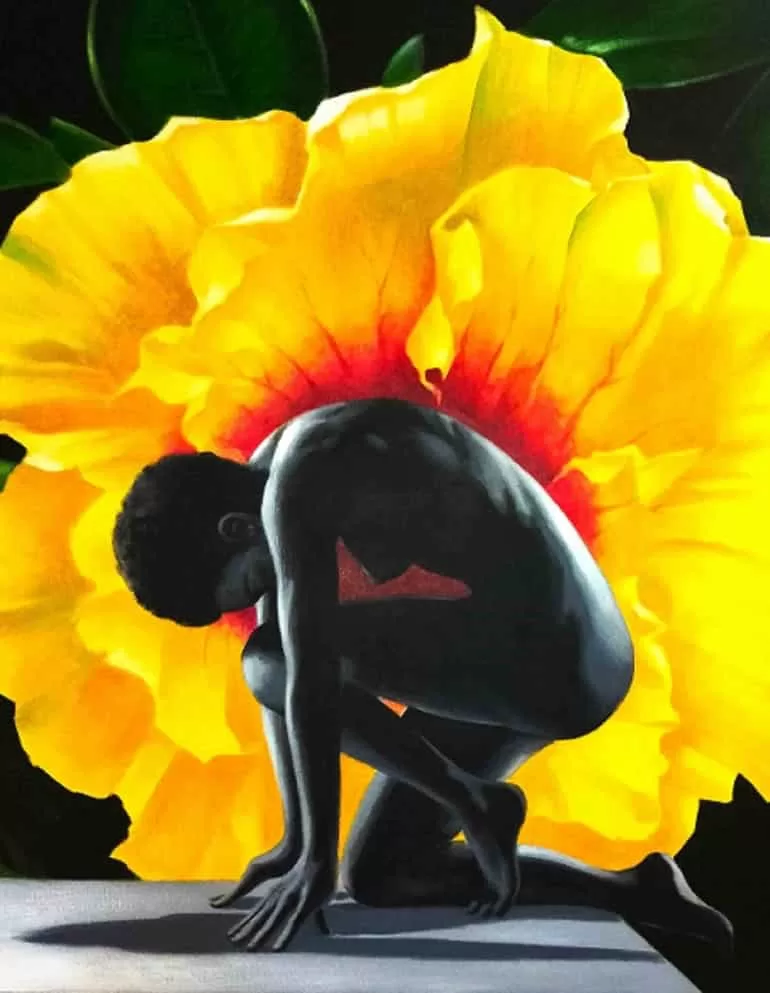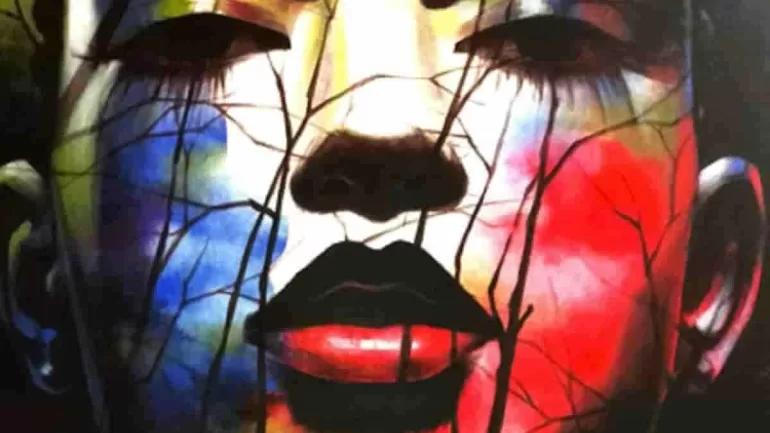ART REVIEW
All the Leaves are on the ground, 2023, Acrylic on Canvas, 160cm x 112cm. This is one of the compelling paintings in Uche Edochie’s philosophical art exhibition. Image courtesy of the artist.
Uche Edochie’s philosophical art exhibition explores human fragility, purpose, and renewal through surreal and symbolic visual storytelling.
BY KAZEEM ADELEKE, ARTCENTRON
LAGOS, NIGERIA —Uche Edochie’s exhibition, All The Leaves Are On The Ground, at Art Pantheon Gallery in Lagos, is a significant point in his 30-year artistic journey. This collection of new works is not a retrospective; rather, it is a deep philosophical statement, showcasing Edochie’s ongoing focus on the human condition, existential purpose, and the pursuit of truth. Since 1995, Edochie has consistently explored themes of thought, nature, and figurative expression. This art exhibition is the culmination of decades of artistic discipline, with each piece imbued with wisdom and narrative depth.
All The Leaves Are On The Ground‘s core theme uses nature’s life cycle to mirror human development. Here, falling leaves are not merely a symbol of decay; instead, they represent renewal. In this collection of philosophical art, Edochie suggests that the fallen leaf is a beginning, not an end. This is a potent reminder that existence starts with inherent fragility, much like a new plant, and grows through conscious awareness and perseverance. Edochie’s new works blend nature’s visual language with the emotional journey of humans. They propose that while consciousness is given, meaning must be acquired through introspection and disciplined action.
Philosophical Art: Interrogating Purpose in Uche Edochie’s Work
Edochie’s paintings are more than just visuals; they are philosophical discussions rendered in acrylic and canvas. The central questions he poses—”Who are we? Why are we here? What is our purpose?”—are not rhetorical. Instead, they are urgent calls to re-evaluate how we live intentionally in a society saturated with noise, distraction, and false meaning. This makes All The Leaves Are On The Ground a truly thoughtful philosophical art exhibition.
Unlike typical figurative art that often idealizes form, Edochie’s canvases engage deeply with the human psyche. Every brushstroke reflects an intellect grappling with identity, memory, and resilience against spiritual erosion and cultural confusion.
Resilience in a Fractured Age: A Central Motif
Resilience is a dominant theme throughout this philosophical art exhibition, a concept Edochie has explored for over two decades. This theme is particularly relevant today, especially for younger generations navigating identity, mental health, and societal dislocation. As mental health issues rise among young people, Edochie presents art not just as an escape but also as a way to understand pain, adaptation, and endurance. His clear statement, “A meaningful life is not guaranteed. Only consciousness is,” underpins his art. It transforms it into an act of resistance against apathy and an invitation to cultivate purpose.
The exhibition’s title, All The Leaves Are On The Ground, is a powerful metaphor for life’s cyclical nature, growth, and personal transformation. It signifies a moment of deep introspection for both the artist and humanity, symbolizing the shedding of innocence, illusions, and old beliefs. The fallen leaves represent the layers individuals discard as they evolve, while the ground they rest on signifies a space of stillness for questioning meaning and fostering renewed purpose. Within this framework, the exhibition prompts viewers to consider what has been given up, as well as what can be regenerated through heightened awareness and rigorous discipline.
Fragile and Vulnerable Stillness
Edochie uses nature to illustrate the fragile, nonlinear path of human development. His figures, both grounded and untethered, embody the tension between collapse and renewal. The title phrase evokes a pause in life’s chaos—a moment when everything has converged and life’s complexities are laid bare. In this vulnerable stillness, Edochie urges reflection on identity, resilience, and the search for meaning in a chaotic world. The phrase is more than a poetic image; it’s a philosophical anchor. It grounds the exhibition in the belief that transformation often begins with confronting the fragmented parts of one’s journey.
Furthermore, the title of this philosophical art exhibition reflects on life’s inherent fragility and the inevitability of change. The metaphor of fallen leaves suggests shedding illusions, past identities, and outdated beliefs. This act of falling signifies not just decay but transition—a space between what has happened and what is yet to come. The leaves on the ground become artifacts of personal history, visible reminders of lived experience. Through this symbolism, Edochie quietly asks the viewer: When everything is exposed, and there’s nothing left to cling to, what remains of the enduring self? Thus, the exhibition marks a chronological milestone in the artist’s thirty-year career. It represents a conceptual reckoning with time, memory, and human potential.
A Journey of Growth and Artistic Influences
Several works in this exhibition tell a story of growth. They trace the artist’s evolution from his first exhibition at the Goethe Institute with the Nsukka School of Art to the present. Even early in his career, Edochie’s distinctiveness among a group of talented artists led by Obiora Udechukwu was clear. His artistic output has changed over time. However, it is not through sudden shifts but continuous accumulation, which is evident in this exhibition. Elements of pastiche, an artistic approach Edochie started and refined shortly after graduating from Nsukka, are still noticeable in several works. Specifically, certain works demonstrate this continuity, showing a convergence of artistic styles and influences, especially from his former professors. Examples include Every Time I See You, Great Expectations, Head in the Clouds, and Pieces of Me where we see the presence of Uli patterns and designs.
Surrealism and Existential Inquiry
A notable aspect of this exhibition is Edochie’s engagement with surrealism. His approach to this genre, while different from previous works, continues his practice of integrating various conceptual streams. Here, Edochie does not draw from Western influences like Salvador Dalí. Instead, his surrealism follows the tradition of the Abayomi Barber Art School, led by the late Abayomi Barber and Muri Odejimi. Beyond the stylistic influence, there is also a thematic focus on existential inquiry.
This existential exploration is vivid in the surrealist painting Consciousness Observing Itself 2025. The work features a vibrant, multicolored portrait of a woman partly hidden by leafless trees and indistinct foliage. The trees merge with the left side of her face, shadowing it, while her visible eye gazes distantly with meditative intensity. Her expression, suspended between alertness and detachment, creates a haunting ambiguity: Is she emerging from the landscape or dissolving into it? The contrast of saturated hues—blues, purples, and reds—with sharp flashes of yellow and white highlights a tension between clarity and obscurity, vitality, and entropy.
The tension inherent in this painting visually expresses the concept of Chi, the vital life force in Igbo cosmology. In this symbolic space, light and darkness are not opposites but coexisting truths. The viewer is prompted to consider whether the darker forces of existence will overshadow the light or if awareness itself is the persistent illumination. This composition invites a metaphysical introspection: When confronting the scattered fragments of one’s life, does one succumb to lamentation, or does one achieve awakening?
In the Landscape of Barren Trees
A thematic continuation unfolds in Consciousness Dreaming 2025. Here, the same female figure reappears, rendered in monochromatic tones, in a state of repose. Before her stretches a sparse landscape of barren trees and a solitary road that disappears into the distance. The deliberate absence of leaves in this dreamscape reflects not only an external desolation but also an inward withdrawal. The road, crossing the foreground and vanishing into the thicket of bare branches, is a visual metaphor for an internal journey. In sleep, the conscious self retreats, yet the mind continues its quest for meaning. The trees, stripped of foliage, stand as sentinels—symbols of endurance, memory, and unfulfilled potential.
Unlike the vibrant introspection of the previous painting, Consciousness Dreaming offers a more subdued revelation. The painting reveals that even in moments of stillness, the human spirit remains in motion. The dream, in this context, functions as an escape and a continuation of observation, with the subconscious actively negotiating the fallen detritus of thought and experience. Together, these two works establish a dialogue—between waking and dreaming, awareness and mystery. They position Edochie’s broader exhibition as a contemplative journey through the landscape of the self.
Flowers and Sprinters in Uche Edochie’s Philosophical Art

The significance of floral imagery is particularly pronounced in several of the new works in this exhibition. These works appear to offer futuristic or metaphorical dimensions that symbolically emerge from the fallen leaves. They evoke themes of renewal and transformation. A sense of rejuvenation—perhaps even a rebirth of the human experience—is palpably conveyed. One painting that powerfully articulates this notion of resilience is Hard to Kill: Ancestral Shields (2023). The composition presents the silhouette of a woman poised in a sprinter’s starting position. Although her head is bowed, her focus is resolute.
The woman’s posture signals the commencement of a new journey undertaken with unflinching determination. Positioned behind her is a luminous marigold flower, emblematic of hope and regeneration. Here, the marigold assumes the symbolic role of the sun. It illuminates the woman’s path as she metaphorically germinates from the decaying leaves—transcending death to embody the seed of future growth. She becomes a figure of transformation rising from the remnants of the past.
A Critique of the Modern World
Edochie directly engages in cultural commentary, embedding in his work a sharp critique of contemporary values. There is a particular focus on the increasing influence of social media algorithms, political agendas, and fleeting digital trends on defining meaning. He challenges viewers to reclaim their narratives from these pervasive forces. He urges, “We as adults need to dig deep and defend the values that define us.” The artist seems to advocate for strict adherence to tradition and the preservation of human dignity and clarity amidst societal disarray.
A striking feature of this exhibition is Edochie’s inclusion of creative writings and introspective journal entries, developed alongside the artworks. This deliberate insertion of his voice into the narrative represents a radical act of artistic self-determination. The dynamic interplay between visual and literary engagement deeply enriches the viewer’s experience. One doesn’t merely observe Edochie’s work; one enters into a dialogue, both with the artist and with oneself. In that sense, his art is not passive; it actively demands participation.
A Call to Wakefulness and Will
All The Leaves Are On The Ground transcends a typical art exhibition; it is a manifesto of spiritual clarity. Uche Edochie compels viewers to stop avoiding fundamental questions and instead confront them. In doing so, he offers a rare commodity in these distracted times: stillness, honesty, and prescient vision. This philosophical art exhibition calls the viewer to confront existence itself—its inherent fragility, its profound promise, and its attendant responsibilities. It is a potent reminder that while leaves inevitably fall, the potential for new life remains perpetually available, contingent upon a conscious and courageous pursuit.
